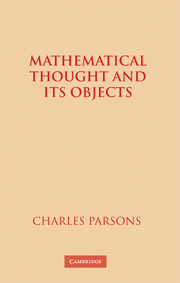1 - Objects and logic
Published online by Cambridge University Press: 24 November 2009
Summary
Abstract objects
The language of mathematics speaks of objects. This is a rather trivial statement; it is not certain that we can conceive any developed language that does not. What is of interest is that, taken at face value, mathematical language speaks of objects distinctively mathematical in character: numbers, functions, sets, geometric figures, and the like. To begin with, they are distinctive in being abstract.
Roughly speaking, an object is abstract if it is not located in space and time and does not stand in causal relations. This criterion gives rise to some uncertain cases and would not be accepted by all philosophers. It is not essential for our purposes that there should be a principled and exhaustive classification of all objects into abstract and concrete. Physical bodies and biological organisms, such as we encounter in everyday life, are concrete. If we assume that sense-perception necessarily involves a causal relation between the object perceived and the organism (the event or state of its perceiving), and that perception locates its objects at least in some rough way, then it follows that the objects of sense-perception are concrete. Thus it is generally assumed in discussions of abstract objects that abstract objects cannot be perceived by the senses.
In this they are not alone. It is not merely for this reason that abstract objects are thought to pose a general philosophical problem.
- Type
- Chapter
- Information
- Mathematical Thought and its Objects , pp. 1 - 39Publisher: Cambridge University PressPrint publication year: 2007



